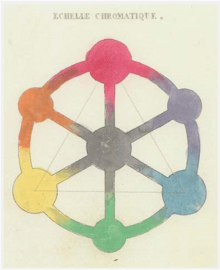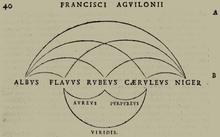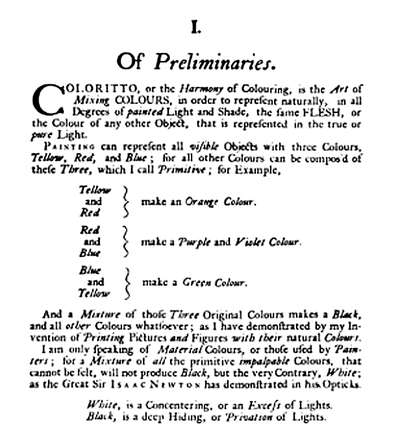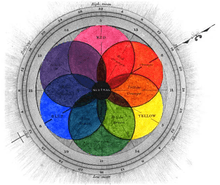RYB color model
RYB (an abbreviation of red–yellow–blue) denotes the use of red, yellow, and blue pigments as primary colors in art and applied design.[1] Under traditional color theory, this set of primary colors pigments was advocated by Moses Harris, Michel Eugène Chevreul, Johannes Itten and Josef Albers, and applied by countless artists and designers. The RYB color model underpinned the color curriculum of the Bauhaus, Ulm School of Design and numerous art and design schools around the world including the Shillito Design School, Sydney.


The RYB Color model features red, yellow and blue. These overlap to create Secondary color segments of orange, green and purple, which in turn overlap to reveal a Tertiary color created from orange, green and purple: brown (not black). This set of primary colors emerged at a time when access to a large range of pigments was limited by availability and cost, and it encouraged artists and designers to explore the many nuances of color through mixing and intermixing a limited range of pigment colors. In this context, red, yellow and blue pigments were usually augmented with white and black pigments, enabling the creation of a larger gamut of color nuances.
The RYB color model relates specifically to color in the form of paint and pigment application in art and design.[2] Other common color models include the light model (RGB) and the printing ink CMY color model, the latter emerging in conjunction with the CMYK color model in the printing industry.
History


The first known instance of the RYB triad can be found in the work of Franciscus Aguilonius (1567–1617), although he did not arrange the colors in a wheel.[3]
The RYB model was used applied to printing by Jacob Christoph Le Blon. In Coloritto (c1723), Le Blon states: "Painting can represent all visible objects with three colours: Yellow, Red, and Blue". Le Blon began to experiment with multicolored printing using four printing plates, each applying three chromatic colorants yellow, red, and blue as well as black.[4]
In the 18th century, Moses Harris advocated that a multitude of colors can be created from three 'primitive' colors - red, yellow and blue.[5]
Similar ideas about the creation of color using red, yellow and blue were discussed in Theory of Colours (1810) by the German poet, color theorist and government minister Johann Wolfgang von Goethe.[6]
In the The Law of Simultaneous Color Contrast (1839) by the French industrial chemist Michel Eugène Chevreul discussed the creation of numerous color nuances and his color theories were underpinned by the RYB color model.[7]
Separate to the RYB color model, cyan, magenta, and yellow primary colors are associated with CMYK commonly used in the printing industry. Cyan, magenta and yellow are often referred to as "process blue", "process red", and "process yellow".[8][9]

See also
- Color
- Color solid
- Color theory
- List of colors
- Primary colors
References
- Gage, John (1995). Colour and Culture : Practice and Meaning from Antiquity to Abstraction. London: Thames & Hudson. ISBN 978-0500278185.
- Gage, John (2000). Color and Meaning: Art, Science, and Symbolism. London: Thames & Hudson. ISBN 978-0520226111.
- "Franciscus Aguilonius". Colorsystem: Colour order systems in art and science. Archived from the original on 2014-02-13.
- Kuehni, R.G and Schwarz, A. (2008). Color Ordered: A Survey of Color Order Systems from Antiquity to the Present. Oxford University Press.CS1 maint: multiple names: authors list (link)
- Harris, Moses (1766). The Natural System of Colours. (Facsimile edition of 1963), New York: Whitney Library of Design.
- Goethe, Theory of Colours, trans. Charles Lock Eastlake, Cambridge, MA: MIT Press, 1982. ISBN 0-262-57021-1
- Chevreul, Michel Eugène (1861). The Laws of Contrast of Colour. London: Routledge, Warne, and Routledge. p. 25. – English translation by John Spanton
- St. John, Eugene (February 1924). "Some Practical Hints on Presswork". Inland Printer, American Lithographer. 72 (5): 805. Retrieved 18 February 2019.
- White, Jan (2003). Editing by Design: For Designers, Art Directors, and Editors—the Classic Guide to Winning Readers. Simon and Schuster. p. PT460. ISBN 9781581159387. Retrieved 18 February 2019.